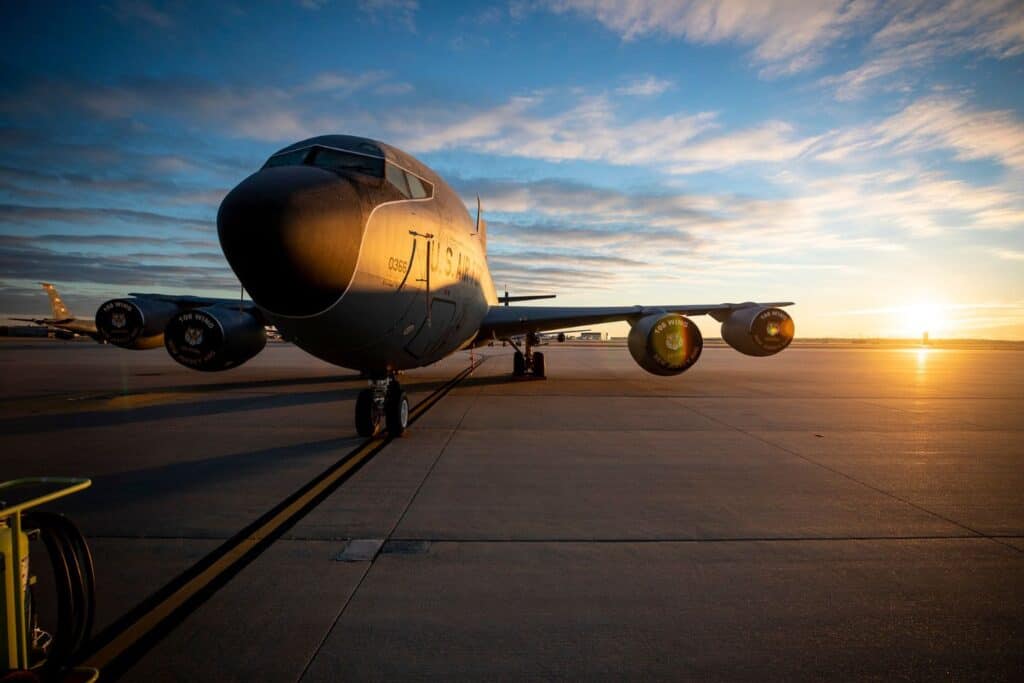
You can read every rule and procedure ever published about flying Space-A and still not know how to have a successful journey. Here’s where the strategy comes into play.
You will learn a lot as you go, but in the meantime, here are seven Space-A flying tips based on what we’ve learned through years of taking “military hops” around the world.
If you’re new to flying Space-A, start with this step-by-step guide to the process.
1. Give Yourself as Many Options as Possible
Depending on where you live, you may have several possible bases from which you could fly.
When we lived in the Washington, DC area and wanted to travel to Europe, we looked for flights from JB Andrews, Dover AFB, Baltimore Washington airport, and Naval Station Norfolk.
We also considered JB McGuire-Dix-Lakehurst as an option. They have many flights to Europe, and it’s fairly easy to fly Space-A from Andrews or Dover to McGuire.
If you don’t live close to a base with an air terminal that has regular flights to your target destinations, consider how you could easily get to an area of the country (such as DC) with several nearby bases. Or make your way to a base that has frequent Space-A flights, even if they aren’t to the place you want to go.
Flights within the contiguous United States (CONUS) are usually less competitive than overseas flights, so chances are good that you can hop to one of the major hubs.
So how do you know which bases have the most flights to the places you want to go? Or which CONUS bases have the most flights from one to another?
2. Monitor the Space-A Flight Schedules
I follow many passenger terminals’ web pages to become familiar with their flight schedules.
Do I look at each terminal’s page daily? Of course not. But I review them periodically, and when we are planning a trip, I focus on the bases we might fly to and from.
| Related Reading: Where to Find Space-A Flight Schedules
For example, for several weeks before we flew Space-A from Japan to Europe in 2019, I monitored the activity at Yokota AB, Osan AB, Kadena AB, Travis AFB, JB Lewis-McChord, JB Elmendorf-Richardson, JB Pearl Harbor-Hickam, and Andersen AFB.
Any of those bases could have been part of our journey, so I watched the schedules to get a sense of how many Space-A seats there were and how many Category 6 Space-A passengers were getting on.
(Here’s more detail on how to figure out which bases fly where.)
3. Pack for Flexibility
On most Space-A flights, passengers can check up to two pieces of luggage weighing up to 70-lbs each.
Still, we advise packing as light as possible and bringing only luggage that qualifies as carry-on (military passenger terminals follow Transportation Security Administration guidelines). Sometimes an aircraft has open seats, but cargo limitations prohibit the addition of more checked bags. Those missions may accept passengers who have only carry-on luggage.
Also, luggage weight limits on certain aircraft are often as low as 25 or 30 lbs per passenger, so if you want to keep all options open, pack accordingly.
Packing for flexibility also means bringing the clothing and gear you need for a comfortable ride on a cargo flight, even if you hope to fly on Patriot Express missions.
Use our Space-A packing list to ensure you have everything you need!
4. Consider Avoiding the Busiest Space-A Locations
Sometimes the busiest air terminal isn’t the best option. For example, many Space-A passengers traveling to and from bases in the Pacific try to fly through Hawaii. But JB Pearl Harbor-Hickam is a major hub and there are a lot of people competing for flights.
In our experience, active duty spouses traveling with children occupy many of the Space-A seats. Unaccompanied spouses are Cat 4 or 5, so if you are in a lower-priority category, it’s easy to get stuck. If you can avoid Hawaii by catching a flight through JB Elmendorf-Richardson in Alaska, you might not face so much competition for seats.
When flying Space-A, you must stay flexible. Sometimes you need to travel out of your way or to a less desirable location to keep moving forward. As an Army buddy advised my husband in his early days of flying Space-A . . .
5. Take the First Thing Smokin’
In other words, don’t wait for the perfect flight. To borrow from an old proverb, a flight departing today is better than two on the schedule for tomorrow.
Let’s say you are at Ramstein AB in Germany trying to return to Dover AFB, where you parked your car. There’s a flight to Dover tomorrow evening, but seats are still TBD. Today there is a flight to Westover Air Reserve Base in Chicopee, Massachusetts with 10 seats available.
You might not know exactly where Chicopee is, but you should try for that flight. Chances are good that you will get a seat, because most of the other Space-A passengers will wait for the Dover flight (Dover is a major Space-A hub). But the Dover mission might not have seats, or it could fall off the schedule entirely.
If you fly to Westover, at least you will have made it across the Atlantic and won’t face the possibility of getting stuck in Germany or paying for an overseas fare.
We employed this strategy on a trip from Hawaii to our home in Rota, Spain.
After staying at Kilauea Military Camp, we made our way to JB Pearl Harbor-Hickam just in time for Roll Call for a mission headed to Travis and then Dover. That would have been a great start for a journey back to Rota, but they only released 19 seats, and we did not make the cut.
Over the next 24 hours, two flights to Travis disappeared from the schedule, so rather than remaining in limbo, paying for lodging in Hawaii, we took the first hop we could get to the continental U.S. The “first thing smokin'” was a rare mission to Selfridge Air National Guard base in Michigan.
As expected, we had little competition for seats. Most other Space-A travelers wouldn’t take a flight to Selfridge, knowing they had little chance of catching another hop from Michigan. But it worked well for us, because we also employed strategy #7 below!
Even if you do get a seat on the exact flight you wanted, keep in mind that nothing is certain until you’re in the air . . .
6. Expect Last-Minute Changes
If you’re planning to compete for a flight within the next 24 hours, call the terminal regularly for updates to ensure you don’t miss a change to Roll Call time.
Other aspects of your target flight can change without notice as well: the number of seats available, the boarding and departure times, even the baggage weight limit.
Flying Space-A can involve a lot of “hurry up and wait.” You may rush to get to the terminal in time for Roll Call, only to sit there for 5 hours before boarding.
Sometimes the terminal will announce a significant delay, only to call for boarding 30 minutes later. Other times you may wait in the terminal all day with bags packed only to find out the flight isn’t taking off until the next day. The terminal staff may give you an idea of whether it’s safe to leave, but often it’s your call.
Finally, the #1 tip when flying Space-A is . . .
7. Have a Plan B
If you read the Quickstart Guide and stories about our experiences, I’m sure you figured out that Flying Space-A is very unpredictable. You should always have a contingency plan (or three).
If you have time, flexibility, and room in your budget to pay for lodging, you can wait for a flight.
When nothing is moving at your location, you can also hop to another base that has more flight options, or you could even spend your vacation at whatever base you land if you still can’t make it to your intended destination.
Of course, flying commercial is always a possibility, and I recommend pricing that option as part of your planning to help you determine whether flying Space-A is likely to save you any money.
A combination of Space-A and commercial can also work well. After taking that hop from Hawaii to Selfridge mentioned above, we flew commercial from Detroit to Norfolk, VA and got seats on a Patriot Express flight from NS Norfolk to Rota.
Despite the cost of the hotel in Detroit and commercial fare to Norfolk, we saved more than $2,200 compared to the cost of flying commercial from Hawaii to Spain.
You can still save money with Space-A, even if you don’t take hops all the way to your destination. Get creative and leave all of your options on the table!
Ready For Your Next Military Hop?
Learning the basics of how Space-A travel works is extremely important, but it’s only the first step. Keep the above tips in mind as you prepare for your journey, during your trip, and when returning home. Most importantly, enjoy the adventure!
Related Reading:
Quickstart Guide to Military Space-A Flying
